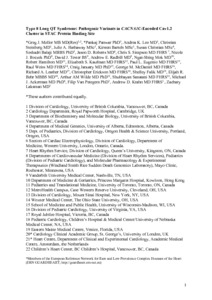Mellor, GJ;
Panwar, P;
Lee, AK;
Steinberg, C;
Hathaway, JA;
Bartels, K;
Christian, S;
Balaji, S;
Roberts, JD;
Simpson, CS;
et al.
Mellor, GJ; Panwar, P; Lee, AK; Steinberg, C; Hathaway, JA; Bartels, K; Christian, S; Balaji, S; Roberts, JD; Simpson, CS; Boczek, NJ; Tester, DJ; Radbill, AE; Mok, N-S; Hamilton, RM; Kaufman, ES; Eugenio, PL; Weiss, R; January, C; McDaniel, GM; Leather, RA; Erickson, C; Falik, S; Behr, ER; Wilde, AAM; Sanatani, S; Ackerman, MJ; Van Petegem, F; Krahn, AD; Laksman, Z
(2019)
Type 8 long QT syndrome: pathogenic variants in CACNA1C-encoded Cav1.2 cluster in STAC protein binding site.
Europace, 21 (11).
pp. 1725-1732.
ISSN 1532-2092
https://doi.org/10.1093/europace/euz215
SGUL Authors: Behr, Elijah Raphael
![[img]](https://openaccess.sgul.ac.uk/111107/6.hassmallThumbnailVersion/LQT8%20CACNA1C%20Final%20Manuscript.pdf)  Preview |
|
PDF
Accepted Version
Available under License ["licenses_description_publisher" not defined].
Download (1MB)
| Preview
|
Abstract
AIMS: Pathogenic gain-of-function variants in CACAN1C cause type-8 long QT syndrome (LQT8). We sought to describe the electrocardiographic features in LQT8 and utilize molecular modelling to gain mechanistic insights into its genetic culprits. METHODS AND RESULTS: Rare variants in CACNA1C were identified from genetic testing laboratories. Treating physicians provided clinical information. Variant pathogenicity was independently assessed according to recent guidelines. Pathogenic (P) and likely pathogenic (LP) variants were mapped onto a 3D modelled structure of the Cav1.2 protein. Nine P/LP variants, identified in 23 patients from 19 families with non-syndromic LQTS were identified. Six variants, found in 79% of families, clustered to a 4-residue section in the cytosolic II-III loop region which forms a region capable of binding STAC SH3 domains. Therefore, variants may affect binding of SH3-domain containing proteins. Arrhythmic events occurred in similar proportions of patients with II-III loop variants and with other P/LP variants (53% vs. 48%, P = 0.41) despite shorter QTc intervals (477 ± 31 ms vs. 515 ± 37 ms, P = 0.03). A history of sudden death was reported only in families with II-III loop variants (60% vs. 0%, P = 0.03). The predominant T-wave morphology was a late peaking T wave with a steep descending limb. Exercise testing demonstrated QTc prolongation on standing and at 4 min recovery after exercise. CONCLUSION: The majority of P/LP variants in patients with CACNA1C-mediated LQT8 cluster in an SH3-binding domain of the cytosolic II-III loop. This represents a 'mutation hotspot' in LQT8. A late-peaking T wave with a steep descending limb and QT prolongation on exercise are commonly seen.
| Item Type: |
Article
|
| Additional Information: |
This is a pre-copyedited, author-produced version of an article accepted for publication in EP Europace following peer review. The version of record Greg J Mellor, Pankaj Panwar, Andrea K Lee, Christian Steinberg, Julie A Hathaway, Kirsten Bartels, Susan Christian, Seshadri Balaji, Jason D Roberts, Chris S Simpson, Nicole J Boczek, David J Tester, Andrew E Radbill, Ngai-Shing Mok, Robert M Hamilton, Elizabeth S Kaufman, Paul L Eugenio, Raul Weiss, Craig January, George M McDaniel, Richard A Leather, Christopher Erickson, Shelley Falik, Elijah R Behr, Arthur A M Wilde, Shubhayan Sanatani, Michael J Ackerman, Filip Van Petegem, Andrew D Krahn, Zachary Laksman, Type 8 long QT syndrome: pathogenic variants in CACNA1C-encoded Cav1.2 cluster in STAC protein binding site, EP Europace, Volume 21, Issue 11, November 2019, Pages 1725–1732 is available online at: https://doi.org/10.1093/europace/euz215 |
| Keywords: |
3D crystal structure, CACNA1C, Electrocardiogram, Genetics, Long QT syndrome, 1103 Clinical Sciences, Cardiovascular System & Hematology |
| SGUL Research Institute / Research Centre: |
Academic Structure > Molecular and Clinical Sciences Research Institute (MCS) |
| Journal or Publication Title: |
Europace |
| ISSN: |
1532-2092 |
| Language: |
eng |
| Dates: |
| Date | Event |
|---|
| November 2019 | Published | | 13 August 2019 | Published Online | | 18 July 2019 | Accepted |
|
| Publisher License: |
Publisher's own licence |
| PubMed ID: |
31408100 |
 |
Go to PubMed abstract |
| URI: |
https://openaccess.sgul.ac.uk/id/eprint/111107 |
| Publisher's version: |
https://doi.org/10.1093/europace/euz215 |
Statistics
Item downloaded times since 22 Aug 2019.
Actions (login required)
 |
Edit Item |



